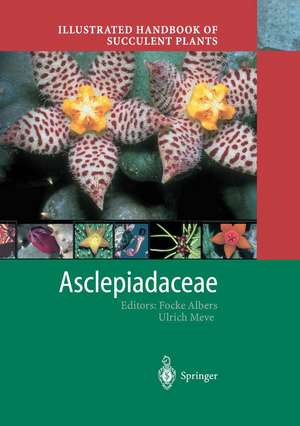Illustrated Handbook of Succulent Plants: Asclepiadaceae: Illustrated Handbook of Succulent Plants
Editat de Focke Albers, Ulrich Meveen Limba Engleză Paperback – 3 oct 2013
With theconstant flow of plant species that reached Europe inthetimes of the great expeditions th th inthe 18 and 19 century,the demandf for anyf form of cataloguing thesteadily growingdiv- sity became unevitable. Succulent plants always fascinated plant-loving people above average, th and the first handbooks devoted to succulents were publishedin the19 century. Initially, h- ever,interest was focussed on the Cactaceae. It was only in 1954/55 when Herman Jacobsen (1898 - 1978), the former curator of the Botanic Garden of Kiel,madeavailablea first handbook devoted to succulents (excl. Cactaceae),the "Handbuchder sukkulenten Pflanzen". An abridged version of this handbook was publishedby Jacobsen as "Sukkulentenlexikon" in 1970. It included descriptions,synonymies and numerous illustrations. The"Sukkulentenlexikon" represented the long-awaited reference work supportingboth Botanical Gardens as well as amateur or prof- sionalgrowers inthe navigation through succulent plant diversity. AnEnglish edition followedin 1975 as "Succulent Lexicon", and a revised German edition was publishedin 1981. This second edition hadbeen finished by Jacobsen's successor inKiel,Klaus Hesselbarth,who,with regard to the Asclepiadaceae, was supportedby the senior editor of the present publication. Over twentyyears have passed since then, and the knowlegdeof succulent plants has increased permanently. Wesaw monographsoff formerly little-known groups and many revisions and - revisions, which often change the taxonomy withinsingle groups considerably. A large amount of new taxa has been published on one hand, and on the other hand, many taxa have been sunk into synonymy.
| Toate formatele și edițiile | Preț | Express |
|---|---|---|
| Paperback (1) | 1058.15 lei 39-44 zile | |
| Springer Berlin, Heidelberg – 3 oct 2013 | 1058.15 lei 39-44 zile | |
| Hardback (1) | 1554.76 lei 39-44 zile | |
| Springer Berlin, Heidelberg – 12 sep 2002 | 1554.76 lei 39-44 zile |
Preț: 1058.15 lei
Preț vechi: 1392.30 lei
-24% Nou
Puncte Express: 1587
Preț estimativ în valută:
202.47€ • 212.53$ • 168.06£
202.47€ • 212.53$ • 168.06£
Carte tipărită la comandă
Livrare economică 07-12 aprilie
Preluare comenzi: 021 569.72.76
Specificații
ISBN-13: 9783642626289
ISBN-10: 3642626289
Pagini: 388
Ilustrații: XII, 321 p.
Dimensiuni: 193 x 270 x 20 mm
Ediția:2004
Editura: Springer Berlin, Heidelberg
Colecția Springer
Seria Illustrated Handbook of Succulent Plants
Locul publicării:Berlin, Heidelberg, Germany
ISBN-10: 3642626289
Pagini: 388
Ilustrații: XII, 321 p.
Dimensiuni: 193 x 270 x 20 mm
Ediția:2004
Editura: Springer Berlin, Heidelberg
Colecția Springer
Seria Illustrated Handbook of Succulent Plants
Locul publicării:Berlin, Heidelberg, Germany
Public țintă
ResearchCuprins
What is a Succulent ?.- How to Use This Handbook.- Scope of Information Presented.- Asclepiadaceae ? family or genus only partially covered.- Absolmsia ? family or genus completely covered (1/0).- Asclepias ? family or genus only partially covered (1/0).- Aspidoglossum ? family or genus completely covered (36/ 0).- Aspidonepsis ? family or genus completely covered (5/0).- Baynesia ? family or genus completely covered (1/0).- Brachystelma ? family or genus completely covered (122/3).- Caralluma ? family or genus completely covered (53/9).- Ceropegia ? family or genus only partially covered (160/18).- Cibirhiza ? family or genus completely covered (2/0).- Cynanchum ? family or genus only partially covered (57/4).- ×Demia ? family or genus completely covered.- Dischidia ? family or genus only partially covered (23 /1).- Dischidiopsis ? family or genus only partially covered (1/0).- Duvalia ? family or genus completely covered (18/3).- Duvaliandra ? family or genus completely covered (1/0).- ×DuvaUaranthus ? family or genus completely covered (1 /0).- Echidnopsis ? family or genus completely covered (32/4).- Edithcolea ? family or genus completely covered (1/0).- Fanninia? family or genus completely covered (1/0).- Fockea ? family or genus completely covered (6/0).- Glossostelma ? family or genus completely covered (12/0).- Hoodia ? family or genus completely covered (14/4).- ×Hoodialluma ? family or genus completely covered.- Hoya ? family or genus only partially covered (55/6).- ×Huernelia ? family or genus completely covered.- Huernia ? family or genus completely covered (67/16).- ×Huernianthus ? family or genus completely covered.- Huerniopsis ? family or genus completely covered (2/0).- Ischnolepis? family or genus completely covered (1/0).- Larryleachia ? family or genus completely covered (5/0).- Lavrania ? family or genus completely covered (1/0).- Madangia ? family or genus completely covered (1/0).- Marsdenia ? family or genus only partially covered (10/0).- Matelea ? family or genus only partially covered (9/0).- Micholitzia ? family or genus completely covered (1/0).- Miraglossum ? family or genus completely covered (7/0).- Notechidnopsis ? family or genus completely covered (2/0).- Odontostelma ? family or genus completely covered (2/0).- Ophionella ? family or genus completely covered (2/ 1).- Orbea ? family or genus completely covered (54/14).- Orbeanthus ? family or genus completely covered (2/0).- ×Orbelia ? family or genus completely covered (1/0).- Pachycarpus ~ family or genus only mentioned; numbers in brackets ; numbers of species/infraspecific taxa covered family or genus only mentioned; numbers in brackets ; numbers of species/infraspecific taxa covered.- Pectinaria ? family or genus completely covered (3/3).- Petopentia ? family or genus completely covered (1/0).- Piaranthus ? family or genus completely covered (7/2).- Pseudolithos ? family or genus completely covered (6/0).- Quaqua ? family or genus completely covered (29/0).- Raphionacme ? family or genus completely covered (35/0).- Rhytidocaulon ? family or genus completely covered (10/1).- Riocreuxia ~ family or genus only mentioned; numbers in brackets ; numbers of species/infraspecific taxa covered family or genus only mentioned; numbers in brackets ; numbers of species/infraspecific taxa covered.- Sarcorrhiza ? family or genus completely covered (1/0).- Sarcostemma ? family or genus completely covered (15/7).- Schizoglossum ?family or genus completely covered (15/ 11).- Schlechterella ? family or genus completely covered (2/0).- ×Staparesia ? family or genus completely covered (1/0).- Stapeha ? family or genus completely covered (47/7).- Stapehanthus ? family or genus completely covered (8/0).- Stapeliopsis ? family or genus completely covered (6/1).- Stathmostelma ? family or genus completely covered (14/4).- Stenostelma ? family or genus completely covered (4/0).- Stomatostemma, (1 /0).- Tavaresia ? family or genus completely covered (3/0).- Trachycalymma ~ family or genus only mentioned; numbers in brackets ; numbers of species/infraspecific taxa covered family or genus only mentioned; numbers in brackets; numbers of species/infraspecific taxa covered.- Tridentea ? family or genus completely covered (8/2).- ×Tromostapelia ? family or genus completely covered.- Tromotriche ? family or genus completely covered (11/0).- White-sloanea ? family or genus completely covered (1/0).- ×Whitesloaniopsis ? family or genus completely covered.- Xysmalobium ~ family or genus only mentioned; numbers in brackets ; numbers of species/infraspecific taxa covered family or genus only mentioned; numbers in brackets ; numbers of species/infraspecific taxa covered.- References.- Taxonomic Cross-Reference Index.
Recenzii
From the reviews:
"The volume on the Asclepiadaceae is now the fifth volume … of the six projected volumes of the Illustrated Handbook of Succulent Plants. Of the five volumes … these are by far the best series of photographs to have been published … . For the interested collector … there is plenty in this book with which to be fascinated. … this is a very attractive volume and will be of considerable use to many collectors … ." (Peter V. Bruyns, Plant Systematics and Evolution, Vol. 239 (3-4), 2003)
"The six volumes of Illustrated handbook of succulent plants … treat ‘over 9000 taxa of all succulents except Cactaceae’ … . This series is a reference manual for taxonomists and horticultural cognoscenti. It compiles up-to-date information not readily available from other sources … . This series is invaluable to identify succulents… . In summary, this is an excellent series, a significant contribution to the literature, and a superb production." (Rudolf Schmid, Taxon, Vol. 53, 2003)
"The volume on the Asclepiadaceae is now the fifth volume … of the six projected volumes of the Illustrated Handbook of Succulent Plants. Of the five volumes … these are by far the best series of photographs to have been published … . For the interested collector … there is plenty in this book with which to be fascinated. … this is a very attractive volume and will be of considerable use to many collectors … ." (Peter V. Bruyns, Plant Systematics and Evolution, Vol. 239 (3-4), 2003)
"The six volumes of Illustrated handbook of succulent plants … treat ‘over 9000 taxa of all succulents except Cactaceae’ … . This series is a reference manual for taxonomists and horticultural cognoscenti. It compiles up-to-date information not readily available from other sources … . This series is invaluable to identify succulents… . In summary, this is an excellent series, a significant contribution to the literature, and a superb production." (Rudolf Schmid, Taxon, Vol. 53, 2003)
Caracteristici
With 332 brillant colour photographs Keys to genera are provided; all accepted taxa are described, including typification and distribution data Full synonymy and literature references are given Ideally suited to the committed collector of succulent plants Includes supplementary material: sn.pub/extras
















